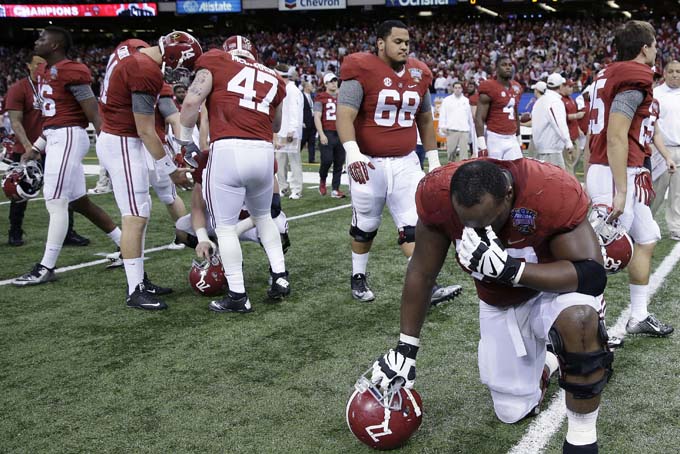
Midway through the first College Football Playoff, one thing really stands out.
Why did it take so long for this to happen?
The two semifinal games produced record TV ratings, packed stadiums, plenty of social media chatter and a bit of controversy. There’s no reason to think Oregon and Ohio State won’t give us another thrilling contest to finish off a memorable season when the national championship is decided Jan. 12 at Arlington, Texas.
So, in a sport that moves at a glacial pace, let’s go ahead and start talking about how to expand this thing. Eight teams is a must. Sixteen would be even better, though that would probably require more radical changes than anyone is willing to accept at the moment.
Until then, the four-team system isn’t too shabby.
Oregon wiped out defending national champion Florida State 59-20 in the Rose Bowl, snapping the Seminoles’ 29-game winning streak. Ohio State upset top-seeded Alabama 42-35 in a thrilling Sugar Bowl, heading to the title game behind a quarterback (Cardale Jones) who was a third-stringer back in August.
“You get to see the two best teams playing for it all,” Ohio State linebacker Darron Lee said. “I’m glad the playoff system is intact now.”
So are we.
With apologies to Big 12 co-champions TCU and Baylor, both of which could certainly make a case for being part of the playoff, there’s little doubt the new system has worked better than even its biggest supporters could’ve predicted.
— The television ratings were off the charts, with ESPN reporting the two-largest audiences in cable television history for the semifinals. The Sugar Bowl averaged 28.271 million viewers, while the less-competitive Rose Bowl wasn’t far behind with 28.164 million. Look for even bigger numbers from the title game.
— The Rose Bowl drew a crowd of more than 91,000, though Florida State had trouble selling its allotment of tickets because it had also played in Pasadena the year before; many Seminoles fans were saving their money for a title game that never materialized. The Sugar Bowl had its largest turnout in eight years (74,682) and an electric atmosphere, with what appeared to be a near-even split between Ohio State and Alabama fans.
— The banana-peel fumble by Florida State quarterback Jameis Winston was a huge hit on social media, giving his many detractors a chance to poke fun at the quarterback who kept getting in and out of trouble during his time in Tallahassee. Our favorite: the Vine in which Lance Stephenson’s exhale into LeBron James’ ear was edited to make it look as though he was blowing over Winston, whose comical play resulted in an Oregon touchdown.
— The Sugar Bowl was the better game, but the Rose Bowl produced more water cooler topics. Florida State coach Jimbo Fisher was caught on the sideline threatening to bench Winston if he didn’t calm down. Several Oregon players did a tacky rendition of Florida State’s tomahawk chant, substituting the words “no means no” in reference to sexual assault allegations against Winston and leading to a hasty apology.
Some coaches expressed worries about the wear-and-tear on their players, especially for the two teams that will wind up playing 15 games — nearly the length of an NFL season. But there was ample time for rest leading up to both the semifinals and final, and having an extra round before the championship figures to improve the quality of play in the biggest game of all.
Under the old BCS system, you might remember, there was a huge gap between the end of the regular season and the championship game. That led to forgettable contests such as Auburn’s 22-19 victory over Oregon in 2011, the second-lowest scoring game of the season for both teams instead of the expected shootout, two of the nation’s most dynamic offenses clearly thrown off by a 37-day layoff.
That shouldn’t be a factor in Arlington, featuring two teams that just combined for 101 points on New Year’s Day.
There are certainly issues with this new system, in which six major bowls rotate the semifinals on an every-three-years basis. The other four bowls are guaranteed an attractive game, but being an also-ran resulted in an awful turnout for Georgia Tech’s victory over Mississippi State in the Orange Bowl, while the Peach Bowl’s 17-year sellout streak ended with TCU’s thumping of Ole Miss.
The other four bowls would surely be better off with a quarterfinal round in their non-semifinal seasons — played around Christmas Day — than they are with games that have no impact on the national championship. But adding another layer to the playoffs would make it even more expensive for a team’s fans to travel to all the games, so it might be better to play the opening round at the campuses of the four highest-seeded teams.
Those are issues we need to start discussing.
But at least we have a playoff. Two teams played their way into the title game, instead of relying on some convoluted ranking system.
Under the BCS, Ohio State’s season would have been over. Instead, the Buckeyes get a shot at a title.
“It’s good for college football,” coach Urban Meyer said. “We’re part of history.”
___
Paul Newberry is a national writer for The Associated Press. Write to him at pnewberry@ap.org or on Twitter at www.twitter.com/pnewberry1963